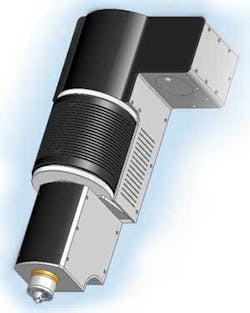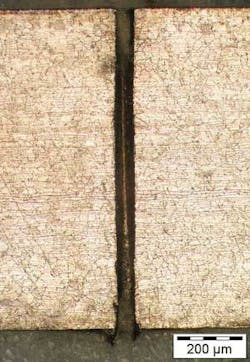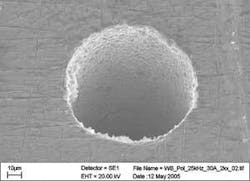Drilling holes
Arnold Gillner and Welf Wawers
Short-pulse lasers deliver precision helical drilling
Manufacturers of electronics, medical devices, sensors, computers, avionics, and so on have a need for parts of miniature sizes and complex shapes and hole patterning. Spinnerets used in the textile industry and injection nozzles for railroad diesel engine injection systems are two examples of extremely fine holes drilled in metal parts. These are typically holes with dimensions of 50 - 100 µm and hole depths up to 2 mm.
Laser hole drilling outperforms wire EDM, chemical etching, mechanical machining/cutting, electroforming, and other processes because the laser process is non-contact and flexible. In addition, there are fewer process limitations, no need for expensive waste disposal, and tooling costs are reasonable. Compared to EDM machining, laser drilling provides high aspect ratios and the capability to drill all types of material, including ceramics, silicon, diamond, and polymers.
With a flexible scanning laser beam even non-circular holes with complex shapes are possible. For creating the very smallest of holes, a family of non-contact, frictionless methods operating with tightly focused light beams has also become established in microelectronic engineering and in the manufacturing of engine parts. Particular difficulties are encountered if the hole has to be conical, with its diameter increasing in the direction of drilling. Geometries of this type are needed in parts such as nozzle blocks whose reverse face is inaccessible. Scientists at the Fraunhofer Institute for Laser Technology (ILT) have developed a method of drilling holes of this shape with a new type of precision drilling optics that provides high scanning speed and micrometer accuracy of the hole geometry.
Drilling holes with laser radiation is a well established technology in a variety of industrial applications. Starting from its first use in the watch industry, the laser has become a versatile tool whenever high-aspect-ratio holes have to be produced under economical conditions such as cooling holes in gas turbine manufacturing or filters in fuel supply systems. In these applications, single-pulse laser drilling or percussion drilling with pulse durations of several microseconds is used to provide high drilling speed. But because laser processes are mainly thermal, laser drilling results in residual melt layers inside the hole. The material, which is molten and vaporized by highly intense laser pulses, condenses and re-solidifies at the wall of the hole before it is carried out of it by its own vapor pressure. This is especially true in percussion drilling, where the laser beam is not moved and always impinges on the same place, resulting in the production of large melting volumes. Shorter pulse lengths in the femto- and picosecond range produce smaller thermal penetration depth but still leave residual molten layers. However, productivity is low when using such lasers due to the insufficient laser power at high pulse energies.
These limitations in quality and productivity can be overcome by using a drilling technology, which is called helical drilling or trepanning, where a tightly focused short-pulse laser beam is rotated around a center point and exactly describes the hole geometry. The drilling is performed by subsequently vaporizing very small portions of the material and by rotating and overlapping well-defined laser pulses. With this drilling technology the wall of the hole is heated during the entire drilling time, which prevents re-solidification and the production of thick white layers. By using this technology, even “long”-pulse lasers in the nanosecond range can be used to allow significant material vaporization and higher productivity as it can be achieved with picosecond lasers. Depending on the focusability of the laser beam, helical drilling optics enable the drilling of circular holes with diameters down to 30 micrometers even at material thickness of 1 mm.
To perform helical drilling, special drilling optics rotate the laser beam with variable rotation diameters and high rotational speed. Several developments were made in the past to perform a high-precision rotation of the laser beam using conventional galvanometer scanners, rotating wedge prisms, and off-axis rotating lenses. All these devices require very high beam quality and an absolute rotational symmetry of the laser beam. Elliptical shaped laser beams or other deviations in the shape would result in non-circular holes. Moreover, the scanning frequency of these devices is limited to a maximum of 3000 revolutions/min. With this scanning frequency a continuous heating of the wall cannot be guaranteed or overheating occurs at high repetition rates of the laser.
To overcome this problem, a new type of laser drilling head has been developed by Fraunhofer-ILT. For the rotation of the laser beam, a beam rotating prism, a so-called dove prism, is used and mounted into a high-speed hollow-shaft motor. With an exact adjustment of the laser beam to the center of the dove prism the laser rotates twice in itself when rotating the prism once. By tilting the laser beam with respect to the rotational axis the beam describes a circle after the focusing lens parallel to the rotation of the laser beam in itself. By shifting the laser beam parallel to the rotation axes, the laser beam describes the circle under an angle of incidence. The dual-conical rotating beam works its way into the depths of the material like a spiral staircase that gets wider towards the bottom. The special geometry of the prism also causes the laser beam to rotate around its own axis at twice the speed of the electric motor, up to 660 times per second. This compensates for any fluctuations in the intensity of the beam as it hits the irradiated surface, resulting in a drilled hole of exceptionally high quality. With this technology conical shaped holes with positive and negative taper can be produced. The use of the dove prism as beam rotator and a scanning device was only possible by the development of a special adjustment device, which is once set together with the dove prism and which compensates the typical errors of beam rotators resulting in noncircular holes.
The newly developed drilling optics allows rotational frequencies of up to 40,000 rpm of the laser beam. Conical shaped holes with diameter ratios of up to a factor of two can be drilled in 2-mm-thick material. The main advantages of the new optics are the very high scanning frequency and the fact that all devices for setting diameter and inclination angle of the laser beam do not rotate and can be built simply as long as they are providing very high accuracy.
With this optics and a Q-switched Nd:YAG laser with 15-nanosecond pulse duration and pulse energy of 600 - 800 µJ, Fraunhofer-ILT researchers have processed tool-quality and high-grade steels up to two millimeters thick. The pulsed laser pierces a hole 50 micrometers in diameter through the metal sheets in less than a quarter of a minute. The residual melt thickness in the hole is as low as 1-2 µm, and the melt on top of the material can be easily removed by ultrasound cleaning. High-precision drilling with a diameter in the range of a few micrometers into metallic components normally is done with short- or ultra-short-pulsed lasers. With the new laser drilling head nanosecond lasers can be used resulting in higher productivity at lower manufacturing costs. Using shorter wavelengths in the green or UV results in smaller spot sizes, and hole diameters of from 10 to 20 µm can be achieved in selected materials. So far tool- and high-grade steels with a material thickness of up to 2 mm were examined. Possible applications are found where conventional drilling of these geometries and precision could not be produced without substantial expenditure.
Arnold Gillner ([email protected]) and Welf Wawers are associated with Fraunhofer Institute for Laser Technology in Aachen, Germany, www.ilt.fraunhofer.de.




